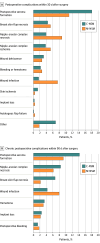Minimal Access vs Conventional Nipple-Sparing Mastectomy
- PMID: 39141399
- PMCID: PMC11325243
- DOI: 10.1001/jamasurg.2024.2977
Minimal Access vs Conventional Nipple-Sparing Mastectomy
Erratum in
-
Error in Figure.JAMA Surg. 2025 Jan 1;160(1):115. doi: 10.1001/jamasurg.2024.5361. JAMA Surg. 2025. PMID: 39504037 Free PMC article. No abstract available.
Abstract
Importance: While nipple-sparing mastectomy (NSM) for breast cancer was only performed using the open method in the past, its frequency using endoscopic and robotic surgical instruments has been increasing rapidly. However, there are limited studies regarding postoperative complications and the benefits and drawbacks of minimal access NSM (M-NSM) compared with conventional NSM (C-NSM).
Objective: To examine the differences in postoperative complications between C-NSM and M-NSM.
Design, setting, participants: This was a retrospective multicenter cohort study enrolling 1583 female patients aged 19 years and older with breast cancer who underwent NSM at 21 university hospitals in Korea between January 2018 and December 2020. Those with mastectomy without preserving the nipple-areolar complex (NAC), clinical or pathological malignancy in the NAC, inflammatory breast cancer, breast cancer infiltrating the chest wall or skin, metastatic breast cancer, or insufficient medical records were excluded. Data were analyzed from November 2021 to March 2024.
Exposures: M-NSM or C-NSM.
Main outcomes and measures: Clinicopathological factors and postoperative complications within 3 months of surgery were assessed. Statistical analyses, including logistic regression, were used to identify the factors associated with complications.
Results: There were 1356 individuals (mean [SD] age, 45.47 [8.56] years) undergoing C-NSM and 227 (mean [SD] age, 45.41 [7.99] years) undergoing M-NSM (35 endoscopy assisted and 192 robot assisted). There was no significant difference between the 2 groups regarding short- and long-term postoperative complications (<30 days: C-NSM, 465 of 1356 [34.29%] vs M-NSM, 73 of 227 [32.16%]; P = .53; <90 days: C-NSM, 525 of 1356 [38.72%] vs M-NSM, 73 of 227 [32.16%]; P = .06). Nipple-areolar complex necrosis was more common in the long term after C-NSM than M-NSM (C-NSM, 91 of 1356 [6.71%] vs M-NSM, 5 of 227 [2.20%]; P = .04). Wound infection occurred more frequently after M-NSM (C-NSM, 58 of 1356 [4.28%] vs M-NSM, 18 of 227 [7.93%]; P = .03). Postoperative seroma occurred more frequently after C-NSM (C-NSM, 193 of 1356 [14.23%] vs M-NSM, 21 of 227 [9.25%]; P = .04). Mild or severe breast ptosis was a significant risk factor for nipple or areolar necrosis (odds ratio [OR], 4.75; 95% CI, 1.66-13.60; P = .004 and OR, 8.78; 95% CI, 1.88-41.02; P = .006, respectively). Conversely, use of a midaxillary, anterior axillary, or axillary incision was associated with a lower risk of necrosis (OR for other incisions, 32.72; 95% CI, 2.11-508.36; P = .01). Necrosis occurred significantly less often in direct-to-implant breast reconstruction compared to other breast reconstructions (OR, 2.85; 95% CI, 1.11-7.34; P = .03).
Conclusions and relevance: The similar complication rates between C-NSM and M-NSM demonstrates that both methods were equally safe, allowing the choice to be guided by patient preferences and specific needs.
Conflict of interest statement
Figures
Comment on
-
Minimally Invasive Nipple-Sparing Mastectomy Can Be Done but Should It?JAMA Surg. 2024 Oct 1;159(10):1187. doi: 10.1001/jamasurg.2024.2986. JAMA Surg. 2024. PMID: 39141380 Free PMC article. No abstract available.
References
Publication types
MeSH terms
LinkOut - more resources
Full Text Sources
Medical
Miscellaneous


